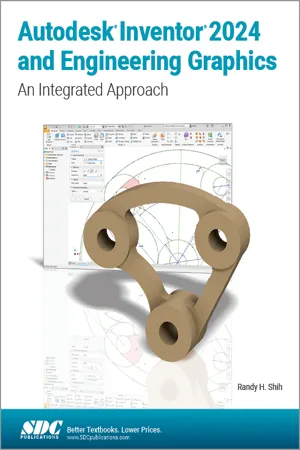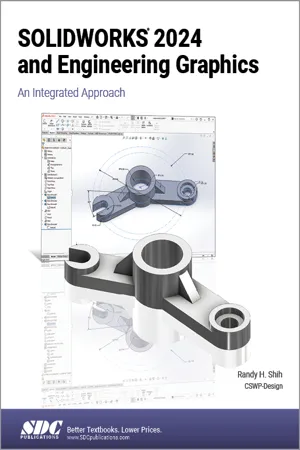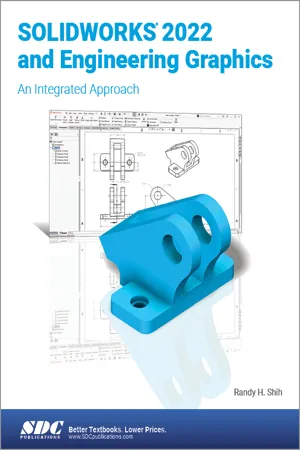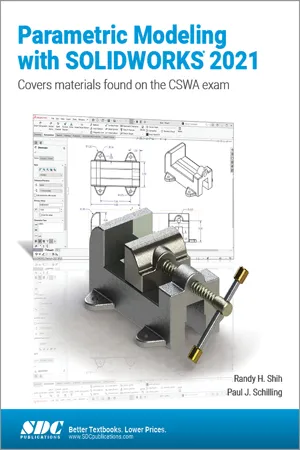Technology & Engineering
Auxiliary View
An auxiliary view is a 2D representation of a 3D object that provides additional information about the object's shape and features. It is typically used in technical drawings and engineering to show details that are not easily visible in standard orthographic views. By providing a different perspective, auxiliary views help to fully communicate the design and dimensions of an object.
Written by Perlego with AI-assistance
Related key terms
1 of 5
9 Key excerpts on "Auxiliary View"
- eBook - PDF
Autodesk Inventor 2024 and Engineering Graphics
An Integrated Approach
- Randy H. Shih(Author)
- 2023(Publication Date)
- SDC Publications(Publisher)
An Auxiliary View is a supplementary view that can be constructed from any of the regular views. A primary Auxiliary View is projected onto a plane that is perpendicular to one of the principal planes of projection and is inclined to the other two. A secondary Auxiliary View is projected onto a plane that is inclined to all three principal planes of projection. In the figures below, the use of the standard views does not show the true shape of the upper feature of the design; the use of an Auxiliary View provided the true shape of the feature and also eliminated the need of front and right side views. Standard Views Auxiliary View 11-4 Autodesk Inventor and Engineering Graphics Normal View of an Inclined Surface No matter what the position of a surface may be, the fundamentals of projecting a normal view of the surface remain the same: The projection plane is placed parallel to the surface to be projected. The line of sight is set to be perpendicular to the projection plane and therefore perpendicular to the surface to be projected. This type of view is known as normal view. In geometry, the word “normal” means “perpendicular.” In the figure below, the design has an inclined face that is inclined to the horizontal and profile planes and perpendicular to the frontal plane. The principal views (Top, Front and Right side views) do not show the true size and shape of the inclined surface. Note the inclined surface does appear as an edge in the front view. To show the true size and shape of the inclined surface, a normal view is needed. To get the normal view of the inclined surface, a projection is made perpendicular to the surface. This projection is made from the view where the surface shows as an edge, in this case, the front view. The perpendicularity between the surface and the line of sight is seen in true relationship in the 2D views. These types of extra normal views are known as Auxiliary Views to distinguish them from the principal views. - eBook - PDF
SOLIDWORKS 2021 and Engineering Graphics
An Integrated Approach
- Randy H. Shih(Author)
- 2021(Publication Date)
- SDC Publications(Publisher)
Auxiliary Views in 2D Drawings An important rule concerning multiview drawings is to draw enough views to accurately describe the design. This usually requires two or three of the regular views, such as a front view, a top view and/or a side view. However, many designs have features located on inclined surfaces that are not parallel to the regular planes of projection. To truly describe the feature, the true shape of the feature must be shown using an Auxiliary View. An Auxiliary View has a line of sight that is perpendicular to the inclined surface, as viewed looking directly at the inclined surface. An Auxiliary View is a supplementary view that can be constructed from any of the regular views. Using the solid model as the starting point for a design, Auxiliary Views can be easily created in 2D drawings. In this chapter, the general procedure of creating Auxiliary Views in 2D drawings from solid models is illustrated. The Rod-Guide Design Based on your knowledge of SOLIDWORKS so far, how would you create this design? What are the more difficult features involved in the design? Take a few minutes to consider a modeling strategy and do preliminary planning by sketching on a piece of paper. You are also encouraged to create the design on your own prior to following through the tutorial. 12-12 SOLIDWORKS 2021 and Engineering Graphics Modeling Strategy Auxiliary Views and Reference Geometry 12-13 Starting SOLIDWORKS 1. Select the SOLIDWORKS option on the Start menu or select the SOLIDWORKS icon on the desktop. The SOLIDWORKS main window will appear on the screen. 2. In the Welcome to SOLIDWORKS dialog box, enter the Advanced mode by clicking once with the left-mouse- button on the Advanced icon. 3. Select the Tutorial_Templates tab. (Refer to Chapter 5 on the setup of template files.) 4. Select the Part_IPS_ANSI template as shown. 5. Click on the OK button to open a new document. - eBook - PDF
SOLIDWORKS 2024 and Engineering Graphics
An Integrated Approach
- Randy H. Shih(Author)
- 2024(Publication Date)
- SDC Publications(Publisher)
Auxiliary Views in 2D Drawings An important rule concerning multiview drawings is to draw enough views to accurately describe the design. This usually requires two or three of the regular views, such as a front view, a top view and/or a side view. However, many designs have features located on inclined surfaces that are not parallel to the regular planes of projection. To truly describe the feature, the true shape of the feature must be shown using an Auxiliary View. An Auxiliary View has a line of sight that is perpendicular to the inclined surface, as viewed looking directly at the inclined surface. An Auxiliary View is a supplementary view that can be constructed from any of the regular views. Using the solid model as the starting point for a design, Auxiliary Views can be easily created in 2D drawings. In this chapter, the general procedure of creating Auxiliary Views in 2D drawings from solid models is illustrated. The Rod-Guide Design Based on your knowledge of SOLIDWORKS so far, how would you create this design? What are the more difficult features involved in the design? Take a few minutes to consider a modeling strategy and do preliminary planning by sketching on a piece of paper. You are also encouraged to create the design on your own prior to following through the tutorial. 12-12 SOLIDWORKS 2024 and Engineering Graphics Modeling Strategy Auxiliary Views and Reference Geometry 12-13 Starting SOLIDWORKS 1. Select the SOLIDWORKS option on the Start menu or select the SOLIDWORKS icon on the desktop. The SOLIDWORKS main window will appear on the screen. 2. In the Welcome to SOLIDWORKS dialog box, enter the Advanced mode by clicking once with the left-mouse- button on the Advanced icon. 3. Select the Tutorial_Templates tab. (Refer to Chapter 5 on the setup of template files.) 4. Select the Part_IPS_ANSI template as shown. 5. Click on the OK button to open a new document. - eBook - PDF
Engineering Design Graphics
Sketching, Modeling, and Visualization
- James M. Leake, Jacob L. Borgerson(Authors)
- 2012(Publication Date)
- Wiley(Publisher)
An Auxiliary View is an ortho- graphic view that is projected onto any plane other than one of the principal planes. A primary Auxiliary View is an Auxiliary View that is pro- jected onto a plane perpendicular to one of the principal planes and inclined to the other two. A primary Auxiliary View can be used to find the true size and shape of an inclined surface. A sec- ondary Auxiliary View is projected from a pri- mary Auxiliary View onto a plane that is inclined to all three principal projection planes. A second- ary Auxiliary View can be used to find the true size and shape of an oblique surface. Auxiliary View Projection Theory Figure 5-2 on page 138 shows an object with an inclined surface that has been placed inside a glass box. Note that the glass box has been modified Figure 5-1 Views of cut block with an inclined surface A A A A 138 CHAPTER 5 AUXILIARY AND SECTION VIEWS by adding an additional plane that is parallel to the inclined surface. For the situation shown in Figure 5-2, the inclined plane (i.e., the auxiliary plane) is perpendicular to the frontal plane and inclined to the horizontal and profile planes. In Figure 5-3 orthographic projection is used to project the object onto the projection planes (i.e., the sides of the glass box), including the aux- iliary plane. Because the auxiliary plane is paral- lel to the inclined surface, the resulting projection shows the true size and shape of the inclined sur- face, as well as foreshortened projections of any other visible surfaces. Also notice that the edge view of the inclined surface appears on the fron- tal projection plane. Now imagine that the frontal plane is hinged to the horizontal, profile, and auxiliary planes. If the hinged views are then unfolded so that they lie in the same plane as the frontal view, Figure 5-4 results. Note that the distance D from the hinge line to the near side of the inclined surface is the same for all three projected views (horizontal, profile, and auxiliary). - David Goetsch, Raymond Rickman, William S. Chalk, , David Goetsch, Raymond Rickman, William S. Chalk, , David Goetsch, Raymond Rickman, William S. Chalk(Authors)
- 2015(Publication Date)
- Cengage Learning EMEA(Publisher)
PROBLEMS 290 section 2 Technical Drawing Fundamentals SUMMARY ● ● An Auxiliary View is a view with its line of sight perpendicular to an inclined surface of an object. An Auxiliary View serves three purposes: (1) it illustrates the true size of a surface, (2) it illustrates the true shape of a surface, and (3) it can project and complete other views. ● ● A secondary Auxiliary View is one that is projected from a primary Auxiliary View to more fully illustrate an object. ● ● A partial Auxiliary View is used to save drafting time and costs by eliminating one or more regular views. ● ● An auxiliary section is an Auxiliary View in sections. It is drawn in the same way as a removed section. ● ● A half Auxiliary View can be used when an auxil-iary view is symmetrical. When this is used, the near half is drawn. REVIEW QUESTIONS Mark the following statements as either true or false. 1. A partial Auxiliary View makes it possible to eliminate one or more of the regular views. 2. Hidden lines in an Auxiliary View should be omitted unless they are needed for clarity. 3. A primary Auxiliary View is always projected from the front view. 4. A reference line should be drawn horizontally and pass through as many points as possible. 5. Use of the half Auxiliary View is very common because it saves time. 6. When laying out a drawing with an Auxiliary View, always choose the view with the most detail as the front view. Answer the following questions by selecting the best answer. 1. Which of the following is not a purpose that an Auxiliary View serves? a. To avoid having to create a removed sectional view b. To illustrate the true size of a surface c. To illustrate the true shape of a surface d. To project and complete other views 2. Which of the following is not a major kind of Auxiliary View? a. Front view b. Top view c. Side view d. Bottom view 3. When we draw an Auxiliary View, projection lines must be drawn at what angle from the inclined surface? a.- eBook - PDF
SOLIDWORKS 2022 and Engineering Graphics
An Integrated Approach
- Randy H. Shih(Author)
- 2022(Publication Date)
- SDC Publications(Publisher)
Auxiliary Views in 2D Drawings An important rule concerning multiview drawings is to draw enough views to accurately describe the design. This usually requires two or three of the regular views, such as a front view, a top view and/or a side view. However, many designs have features located on inclined surfaces that are not parallel to the regular planes of projection. To truly describe the feature, the true shape of the feature must be shown using an Auxiliary View. An Auxiliary View has a line of sight that is perpendicular to the inclined surface, as viewed looking directly at the inclined surface. An Auxiliary View is a supplementary view that can be constructed from any of the regular views. Using the solid model as the starting point for a design, Auxiliary Views can be easily created in 2D drawings. In this chapter, the general procedure of creating Auxiliary Views in 2D drawings from solid models is illustrated. The Rod-Guide Design Based on your knowledge of SOLIDWORKS so far, how would you create this design? What are the more difficult features involved in the design? Take a few minutes to consider a modeling strategy and do preliminary planning by sketching on a piece of paper. You are also encouraged to create the design on your own prior to following through the tutorial. 12-12 SOLIDWORKS 2022 and Engineering Graphics Modeling Strategy Auxiliary Views and Reference Geometry 12-13 Starting SOLIDWORKS 1. Select the SOLIDWORKS option on the Start menu or select the SOLIDWORKS icon on the desktop. The SOLIDWORKS main window will appear on the screen. 2. In the Welcome to SOLIDWORKS dialog box, enter the Advanced mode by clicking once with the left-mouse- button on the Advanced icon. 3. Select the Tutorial_Templates tab. (Refer to Chapter 5 on the setup of template files.) 4. Select the Part_IPS_ANSI template as shown. 5. Click on the OK button to open a new document. - eBook - PDF
Engineering Design Graphics
Sketching, Modeling, and Visualization
- James M. Leake, Molly Hathaway Goldstein, Jacob L. Borgerson(Authors)
- 2022(Publication Date)
- Wiley(Publisher)
CHAPTER 8 SECTION AND Auxiliary ViewS 214 washers, bushings, gaskets, bolts, screws, keys, rivets, pins, bearings, spokes, and gear teeth are not sectioned where the cutting plane lies along the longitudinal axis of the part. ❚ Auxiliary ViewS Introduction Recall that in a multiview drawing of an object with an inclined surface, in one multiview the inclined surface is seen on edge, whereas in the other two multiviews the inclined surface appears as a foreshortened (i.e., not true-size) surface. In Figure 8-25, for example, the inclined surface labeled A is seen on edge in the top view, and as a foreshortened surface in the front and right views. In some circumstances though, a view showing the true size of an inclined surface is useful. From descriptive geometry 1 it is known that the true size and shape of a planar face (or the true length of a line) can be represented in an orthographic projection only if the line of sight is normal to the planar face, or, equivalently, if the projection plane is parallel to the face. This knowledge will be put to use to find the true size of an inclined surface. Definitions In earlier chapters we saw that multiview pro- jection is an orthographic projection technique wherein a three-dimensional object is projected onto one of three mutually perpendicular planes. These are the principal planes: horizontal, frontal, and profile. An Auxiliary View is an orthographic view that is projected onto any plane other than one of the principal planes. A primary Auxiliary View is an Auxiliary View that is projected onto a plane perpendicular to one of the principal planes and inclined to the other two. A primary Auxiliary View can be used to find the true size and shape of an inclined sur- face. A secondary Auxiliary View is projected from a primary Auxiliary View onto a plane that is inclined to all three principal projection planes. A secondary Auxiliary View can be used to find the true size and shape of an oblique surface. - eBook - PDF
- Paul J. Schilling, Randy H. Shih(Authors)
- 2021(Publication Date)
- SDC Publications(Publisher)
An Auxiliary View is a supplementary view that can be constructed from any of the regular views. Using the solid model as the starting point for a design, Auxiliary Views can be easily created in 2D drawings. In this chapter, the general procedure of creating Auxiliary Views in 2D drawings from solid models is illustrated. The Rod-Guide Design Based on your knowledge of SOLIDWORKS so far, how would you create this design? What are the more difficult features involved in the design? Take a few minutes to consider a modeling strategy and do preliminary planning by sketching on a piece of paper. You are also encouraged to create the design on your own prior to following through the tutorial. 9-4 Parametric Modeling with SOLIDWORKS Modeling Strategy Reference Geometry and Auxiliary Views 9-5 Starting SOLIDWORKS 1. On your own, open SOLIDWORKS. If the Welcome dialog box does not appear automatically, click the Welcome to SolidWorks icon in the Task Pane or on the Menu Bar. 2. In order to access the custom template you created in the last Chapter 4, click once with the left-mouse-button on the Advanced icon in the Welcome dialog box. 3. Select the Tutorial_Templates tab. (NOTE: If your templates are not available, open the standard Part template and set the Drafting Standard to ANSI and the Units to IPS.) 4. Select the Part_IPS_ANSI template as shown. 5. Click on the OK button to open a new document. Applying the BORN Technique 1. Select the Hide/Show Items icon on the Heads-up View toolbar to reveal the pull-down menu. In the pull-down menu, toggle on the View Planes and View Origins buttons. 2. In the FeatureManager Design Tree window, select the Front, Top, and Right Planes by holding down the [Ctrl] key and clicking with the left-mouse-button. 3. Click on any of the planes to display the option menu. Click on Show to toggle ON the display of the planes. 4. On your own, toggle ON the display of the Origin. - Randy H. Shih(Author)
- 2021(Publication Date)
- SDC Publications(Publisher)
The reference plane is, typically, a flat surface or a plane which runs through the center of the object. The distances of the individual corner to the reference plane are then used as measurements to construct the Auxiliary View. • The following steps outline the general procedure to create an Auxiliary View: 1. Construct the necessary principal views, in this case, the front and top views. 2. Construct a reference plane line aligned to a flat face and perpendicular to the inclined surface of the object, in this case, the back face of the object. Auxiliary Views 10-9 3. Construct a reference line parallel to the edge view of the inclined surface and construct the projection lines perpendicular to the edge view of the inclined surface. 4. Using the corresponding distances, such as the depth of the object, construct the inclined surface. 5. Complete the Auxiliary View by following the principles of orthographic projection. 10-10 Principles and Practice Partial Views The primary purpose of using Auxiliary Views is to provide detailed descriptions of features that are on inclined surfaces. The use of an Auxiliary View often makes it possible to omit one or more standard views. But it may not be necessary to draw complete Auxiliary Views, as the completeness of detail may be time consuming to construct and add nothing to the clearness of the drawing. In these cases, partial views are often sufficient, and the resulting drawings are much simplified and easier to read. • To clarify the relationship of partial Auxiliary Views and the standard views, a center line or a few projection lines should be used. This is especially important when the partial views are small. • In practice, hidden lines are generally omitted in Auxiliary Views, unless they provide clearness to the drawings. Partial Auxiliary View Partial Top View
Index pages curate the most relevant extracts from our library of academic textbooks. They’ve been created using an in-house natural language model (NLM), each adding context and meaning to key research topics.








